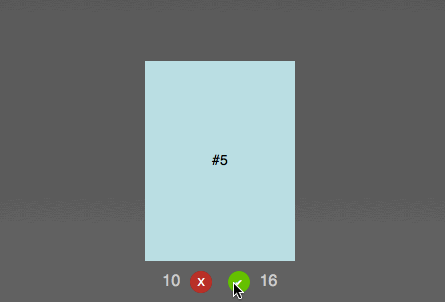Using tinderesque you can build your own Tinder-like card animation. It is far from the complexity of the real interface, but is a nice way to spice up a list sorter.
If you want to see a demo, check out the cuter demo included here that allows you to pick cute animals from a deck and get a list of all of them as a result.
The whole functionality of Tinderesque revolves around CSS animations and their JavaScript events. You style and tweak the animations in the tinderesque.css file.
The Demo Page should show you all you need, it is more or less as simple as including the JavaScript and CSS file into your HTML document and provide it with the proper HTML. The construct for a sortable list is the following:
<div class="cardcontainer list">
<ul>
<li class="card current">#1</li>
<li class="card">#2</li>
<li class="card">#3</li>
<li class="card">#4</li>
<li class="card">#5</li>
<li class="card">#6</li>
</ul>
<button class="but-nope">X</button>
<button class="but-yay">✔</button>
</div>- The
cardclasses are defining the elements to animate and remove. - The
currentclass defines the currently visible one - The
but-nopeandbut-yaybuttons have click handlers attached to them, so button elements are the winner here.
Cards that have been voted on will be removed from the document. The functionality is purely driven by CSS animations, their callback events and you can extend the basic functionality by listening and reacting to custom events:
nopecardfires when the user clicked the "no" buttonyepcardfires when the user clicked the "yes" buttoncardchosenfires when the user clicked the current carddeckemptyfires when all cards are gone - you can use this to pull new content
Each of the custom events has a payload of three DOM references:
origin- the button clicked to fire the event (yes or no)container- the deck container (as there may be several on the same page)card- the HTML of the card that was removed (in case you need to read the contents)
The deckempty event has no card in its payload, the cardchosen event has no origin.
You react to users pressing the yay or nay buttons by listening for the the nopecard and yepcard custom events. This is how I created the nopes and yays counters in the last demo of the intro page.
document.body.addEventListener('nopecard', function(ev) {
var container = ev.detail.container;
var label = container.querySelector('.nopes');
if (label) {
var nopes = +container.nopes || 0;
nopes++;
container.nopes = nopes;
label.innerHTML = container.nopes;
}
});
document.body.addEventListener('yepcard', function(ev) {
var container = ev.detail.container;
var label = container.querySelector('.yays');
if (label) {
var yeps = +container.yeps || 0;
yeps++;
container.yeps = yeps;
label.innerHTML = container.yeps;
}
});You can use the deckempty custom event to re-stack the deck. In the demo page this is done thusly:
document.body.addEventListener('deckempty', function(ev) {
var container = ev.detail.container;
var list = container.querySelector('.cardlist');
var out = '<li class="card current">#1</li>';
for (var i = 2; i < 6; i++) {
out += '<li class="card">#' + i + '</li>';
}
list.innerHTML = out;
});This should get you well on the way…
That's the beauty of open source. Fork, build and send me a pull request.
